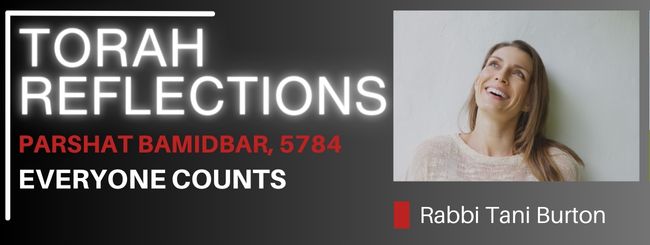בס”ד
Parshat Bamidbar
Integrating Torah into one’s life through reflection and conversation can be an incredibly fun and engaging experience. It’s a journey of discovery, where ancient wisdom and timeless teachings come to life in our daily experiences. Through reflection, we have the opportunity to dive deep into the rich tapestry of Torah, extracting profound insights and lessons that resonate with our modern lives. The joy lies in the ‘aha’ moments, those instances when a Torah verse or story suddenly connects with our personal challenges, aspirations, and values. And when we engage in conversations about Torah with others, it becomes an interactive exploration, where diverse perspectives and interpretations enhance our understanding. These dialogues often spark excitement and intellectual curiosity, making the learning process both enjoyable and fulfilling. Torah becomes a vibrant and dynamic part of our lives, offering not just guidance but also a source of endless fascination, connection, and growth.
NOTE: Don’t feel obligated to go through every source or answer all the questions—unless you want to. Even one source, or one question will give you plenty of material for discussion and meditation. Enjoy this!
Some thoughts from the parsha
This week’s parsha, at first glance, seems like an organizational chart, denoting the total number of people, where they sit and what their jobs are. It would be easy to breeze through these passages, assuming that they are simply dry and technical logistic arrangements and not essential to the Torah narrative. Yet, there is a very deep concept that is embedded in the seating chart of the Children of Israel.
Rabbi Mordechai Yosef Leiner, of blessed memory, was known as the Izhbitzer Rebbe. In his sefer, Mei Shiloach, he makes the following point. The parsha begins with an instruction to Moses to count the heads of the Jewish people, specifically males between the ages of 20 and 60. The language of the commandment is se’u et rosh, literally– “lift up the heads”—but more freely, “count the heads”. The Izhbitzer explains that se’u is related to the word nesi’ut, or “leadership, office”. In Berachot 58a, it is mentioned that no one’s perspective is the same as another’s. G-d gives to each individual their own goodness and life, with no one’s portion similar to another’s. Therefore, He commanded Moses, “lift up the heads”, meaning, let each and every person come to his or her right place, the unique space that has been designated for him or her. And through this, that person will receive their commission, their “office”, their aspect of leadership.
An orchestra is comprised of musicians playing different instruments. Each one must play his or her part. The harpist can’t play the tuba’s part. Nor can the violinist play the timpanist’s part. Yet, each one is essential to the overall symphony. All the musicians surround the conductor, who brings the disparate parts together to create a unified piece of music. Similarly, the Children of Israel were situated around the Tabernacle and thereby united as individuals in the service of G-d. This template is relevant to all humanity, who, by placing G-d at the center, can contribute to the creation of a G-dly world as individuals, together.
Now, reflect upon the following questions
1. What does it mean to “lift up the heads” in our lives? How can we interpret this concept of acknowledging and valuing each individual’s unique perspective and role?
2. Reflecting on the analogy of an orchestra, how does it relate to our lives and relationships? Are there instances where we’ve experienced harmony or discord within our communities or families, and how did individual contributions play a role?
3. Considering the idea that everyone has their own “office” or aspect of leadership, how can we encourage and support one another in discovering and fulfilling our unique roles?
4. In what ways do we see individuals coming together to create a unified whole in our communities or society? How can we actively contribute to this unity while still embracing our individuality?
5. How can we incorporate the notion of placing something greater than ourselves at the center of our lives, whether it be a spiritual belief, a shared purpose, or a common goal, to foster unity and cooperation in our relationships and communities?
Shabbat Shalom!
By Rabbi Tani Burton
If you want more questions for contemplation, SEE THE OTHER BLOGS FROM RABBI TANI BURTON ABOUT DE PARSHAT QUESTIONS
© Copyright, all rights reserved. If you enjoyed this article, we encourage you to distribute it further.
Our blogs may contain text/quotes/references/links that include copyright material of Mechon-Mamre.org, Aish.com, Sefaria.org, Chabad.org, and/or AskNoah.org, which we use in accordance with their policies.

What a nice comparison with that orchestra. What does an orchestra always do once they have taken their place on stage, but before the concert starts? All instruments are tuned. Not only on each other, but also within the instrument itself. There, a string must be tuned to the other string, tubes must be pulled out or pushed back in for wind instruments. Sometimes tuning is also necessary between pieces to maintain the harmony of the tones
Thanks for the command.